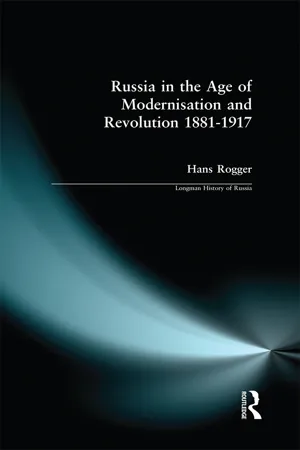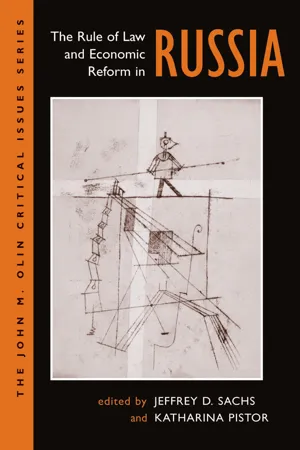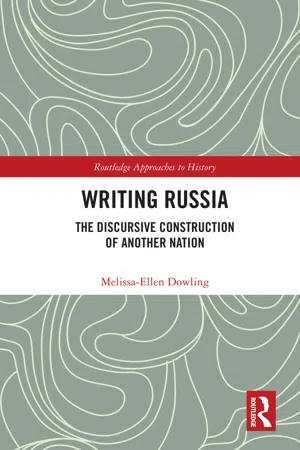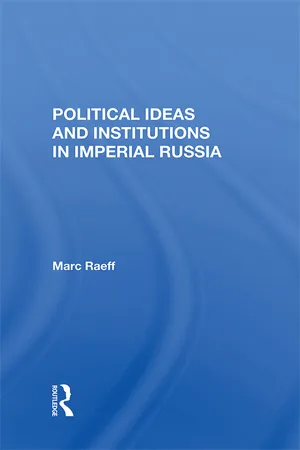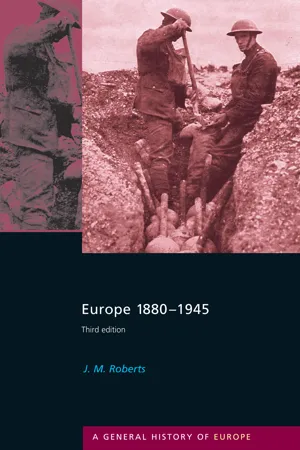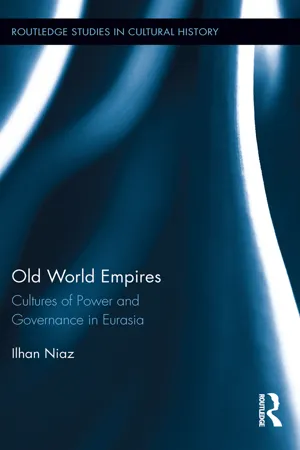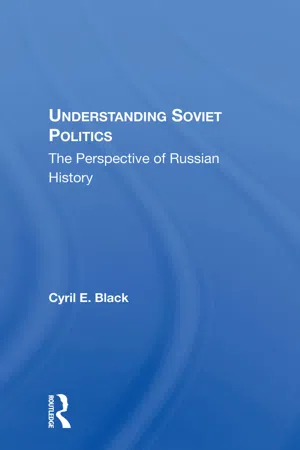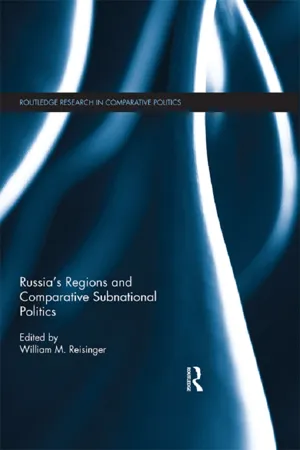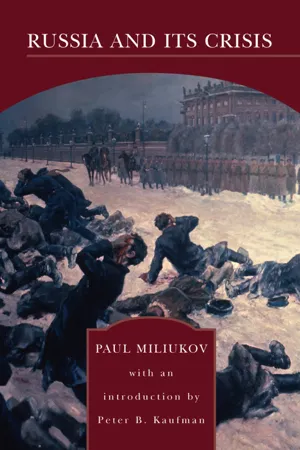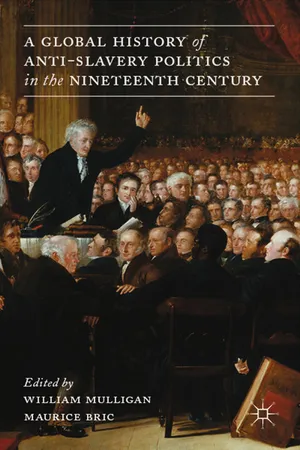History
Russian Autocracy
Russian Autocracy refers to the system of government in Russia where the Tsar held absolute power and authority. This form of autocratic rule was characterized by the lack of a constitution, limited political freedoms, and the suppression of dissent. The Tsar's authority was often justified by the belief in his divine right to rule, and this system persisted until the Russian Revolution of 1917.
Written by Perlego with AI-assistance
Related key terms
11 Key excerpts on "Russian Autocracy"
- eBook - ePub
Historiography of Imperial Russia: The Profession and Writing of History in a Multinational State
The Profession and Writing of History in a Multinational State
- Thomas Sanders(Author)
- 2015(Publication Date)
- Routledge(Publisher)
37 This short work possessed an appealing triumphal quality with its emphasis on religious feats: the glorious conversion of the Russians to Orthodoxy under Vladimir I and the equally glorious victory of the Orthodox over the Tatar Horde under Ivan III. The rest of the book, though, consists of brief descriptions of princes and tsars whose quiescence was their paramount feature; they seemingly did little more than come to the throne, build a stone church or monastery, and then go to their heavenly reward. The abandonment of both this image of a passive ruler and a religious teleology marked the major innovation of eighteenth-century Russian historians.Another similarity among these historians was their use of a common vocabulary but lack of precision in speaking about autocracy. They equated Russian Autocracy (samoderzhavie ) and European absolutism (edinovlastie ) and used them interchangeably along with the generic monarchy (monarkhiia ), and invested all the terms with the notion of the “independent and unrestricted power of one ruler, under God.”38 The historians also subscribed to the widely held opinion of the time that there existed three equally valid forms of government, each with its own corrupt form: monarchy (autocracy)/despotism; aristocracy/oligarchy; and democracy/anarchy.39 Their discussions therefore centered on whether autocracy, despite the risk of despotism, might still be preferable in Russia to aristocracy or democracy, with their threat of becoming oligarchic or anarchic.Despite these similarities among the historians, their differences in interpreting autocracy remain their single most prominent characteristic. These differences lend them what John B. Bury would call their “permanent interest,” the fact that each arose “at a given epoch and is characteristic of the tendencies and ideas of that epoch” and especially, one may add, in an era when histories were unabashedly subjective.40 While proclaiming the value of Baconian methodology in the search, compilation, analysis, and publication of major historical documents,41 interpretive history was more prized in the eighteenth century and was still viewed throughout Europe as a branch of literature or as a practical extension of philosophy—philosophy teaching by example—and was expected to reflect the writer’s own perceptions.42 - H. Rogger(Author)
- 2014(Publication Date)
- Routledge(Publisher)
Chapter TwoTsar, autocrat, and emperorRussian Autocracy was not an ancient despotism in which neither law nor custom protected persons and property from a totally arbitrary authority. And compared with the murderous excesses of twentieth-century totalitarianism, pre-revolutionary Russia looks tolerant, even idyllic. After Stalin and Hitler, it appears remarkable that only four of the regicide conspirators of 1881 were hanged and that many more of their comrades of 'The People's Will' were merely imprisoned or exiled. Some, like Vera Figner, survived to become heroes to a new generation of revolutionaries or to rejoin the battle against autocracy.That Russians measured their government by the standards of a less cruel age is but one reason why so many of them found it oppressive, capricious, or unresponsive. They also compared it unfavourably with what they knew of law and politics in the West where the participation of solid citizens in public life was tolerated or encouraged. A Russian professional or landed proprietor who felt as civilized as any European, could hardly be flattered on learning that at the accession of Nicholas II, Turkey, Montenegro, and Russia were the only European countries without a parliament. He could, moreover, judge his government by rules it had laid down for itself.The Fundamental Laws of 1832 proclaimed: 'The Russian Empire is ruled on the firm basis of positive laws and statutes which emanate from the Autocratic Power.' There was, then, a standard by which to gauge the legality of its acts, especially since the Council of State, established in 1810, had to review all legislation originating in the administration before it was submitted for the emperor's approval. That Alexander I as well as Alexander III confirmed the minority view in one third of the decisions on which the Council was divided illustrates that the monarch was supreme over institutions as well as laws. His supremacy was anchored in the first article of the Code of Laws which set forth the unlimited authority of the autocratic sovereign. It was further buttressed by the fact that until 1906 an imperial decree (imennoi ukaz- eBook - ePub
- Jeffery Sachs(Author)
- 2019(Publication Date)
- Routledge(Publisher)
This chapter is organized as follows. First, it offers brief definitions of autocracy and the rule of law in their historical contexts. This discussion analyzes the persistence of the Russian autocratic tradition over the past several centuries, during which occasional episodes of reform from above alternated with long periods of bureaucratic resistance to reform. Next, it examines two crucial episodes in the late nineteenth century, when major economic reforms based on the rule of law seemed possible: the era of the Great Reforms (1861–1874) and the period of rapid industrial development under Minister of Finance Sergei Iu. Witte (1892–1903). After consideration of why these reforms failed, the discussion concludes with some thoughts on the prospects for the rule of law in the post-Soviet economy.The Concepts of Autocracy and the Rule of Law
The standard definition of Russian Autocracy (samoderzhavie) has two components. The primary meaning relates to foreign affairs as a ruler who has no foreign overlord enjoys autocratic power, literally “ruling by oneself.” In the absence of internal checks and balances, the term connotes absolute power as well. By the end of Tatar rule, conventionally dated in 1480, the grand principality of Muscovy had made the transition to this system. Over the centuries, in medieval Muscovy, the Russian Empire, and the Soviet Union, the autocratic government required personal service from most if not all of its subjects, issued a host of arbitrary laws, and remained immune from constitutional restraints on its executive power.4A distinction must be drawn between the rule of law and rule through law. The vast number and complexity of the laws promulgated by Russian autocrats had nothing to do with the defense of human rights or limits on the power of the tsar. The enormous Polnoe sobranie zakonov (Complete Collection of Laws, 1649–1913, hereinafter PSZ) and its supplement, the Sobranie uzakonenii i rasporiazhenii pravitel’stva (Collection of Governmental Statutes and Decrees, 1863–1917, hereinafter SURP), together with the various codes of laws issued from 1497 onward, indicated the vigor with which tsarist bureaucrats sought to regiment society by means of statutory compulsion and restriction. The law functioned as an administrative device, not as a set of rules to be obeyed by state officials. For example, profiles of all corporations founded in the Russian Empire are contained in the PSZ and the SURP because every new corporate charter took the form of a law.5 - eBook - ePub
Writing Russia
The Discursive Construction of AnOther Nation
- Melissa-Ellen Dowling(Author)
- 2021(Publication Date)
- Routledge(Publisher)
This demonstrative history gives context to the conceptual insights furnished by discordus and emplotment while also providing a clearer and substantive link between theory and practice in historiography. This short history of Russian authoritarianism is written in a way which emphasises the tragic emplotment which is characteristic of Anglophone histories of Russia. Like the idea of Russia which emerges from the history texts analysed throughout this book, the Russia of my text is also a nation which will always be Other. Despite its struggle to liberalise and democratise, Russia (according to the story) will never be Western. Authoritarianism is not only an affliction for Russia but also its defining trait.Notes
1 Nicolai Petro, The Rebirth of Russian Democracy (Cambridge, MA: Harvard University Press, 1995), 31; see also Geoffrey Hosking, Russian History: A Very Short Introduction (Oxford: Oxford University Press, 2012), 49.2 Richard Pipes, Russia Under the Old Regime (New York: Scribner, 1974), 31–56.3 Pipes, Russia Under the Old Regime, 56.4 Roger Bartlett, A History of Russia (New York: Palgrave Macmillan, 2005).5 Marie Mendras, Russian Politics: The Paradox of a Weak State (London: Hurst, 2012), 31; Hosking, Russian History, 84–85.6 Pipes, Russia Under the Old Regime.7 Pipes, Russia Under the Old Regime, 41.8 Glenn Curtis, Russia: A Country Study (Washington: Library of Congress, 1998), 12.9 Pipes, Russia Under the Old Regime, 21.10 Quoted in Alexander Polunov, Russia in the Nineteenth Century: Autocracy, Reform, and Social Change, 1814–1914 - Marc Raeff(Author)
- 2019(Publication Date)
- Routledge(Publisher)
Six The Russian Autocracy and Its Officials 1 1 THE UNDERGRADUATE STUDYING for his final examination in Russian domestic history no doubt often feels that it consisted merely of a series of futile attempts at reforming the political and social structure of the Empire. 2 Successive rulers and their ministers appear to have devoted the best of their time and energies to devising measures which, they fondly hoped, would bring some order to the "chaotic structure of the Empire" (in the words of Alexander I). So much effort was spent on drafting and implementing various reforms that no time seems to have been left: for a systematic study of the country's condition and for the working out of long-range policies. And how often does the historian put down the records of the deliberations of administrative bodies or the memoirs and letters of officials with a feeling of the complete absence of any purposefulness or continuity in the actions of the Imperial government? And while this original feeling may be qualified somewhat by subsequent analysis and research, the basic impression of the lack of direction in the tsar's administration will not be eradicated. The origin of this state of affairs is not hard to see. By saddling the government with new tasks and problems, Peter the Great radically changed the traditional foundation of the Russian state. The Muscovite concept that Russia was a patrimony (votčina) of the tsar, to be administered and exploited like a private domain, made way for the notion of the state as a political and social institution, separate from the person of the ruler, with tasks and problems of its own. But in effecting this change, Peter the Great failed to provide the "new" state with an administration capable of insuring its smooth operation. To use a modern industrial simile, Peter I set up a new type of production, while neglecting to hire the technical personnel capable of running and adjusting the new machinery- eBook - ePub
- J.M. Roberts(Author)
- 2013(Publication Date)
- Routledge(Publisher)
Chapter 6 Autocracy and conservatismThree great dynastic empires dominated central and eastern Europe. Only one of them (the Russian) was in 1880 formally an autocracy, but all three were, in different ways, resistant to the liberal and constitutional ideas so widely accepted in western Europe and diffused by the French Revolution, Russia, Austria-Hungary and Germany all also shared in varying degree a common problem: the existence of alien nationalities within their borders which, it was believed, might endanger the unity of the state. Their tyrannical rule of Poland since the eighteenth century provided the outstanding example. All three states were also ruled by monarchs who still saw them in the old dynastic way as, in a sense, personal and family estates whose function was to support the dignity and standing of the ruling house. Hohenzollerns had ruled Prussia, Habsburgs Austria and Romanovs Russia longer than the Hanoverians had ruled England. Furthermore, though Germany had already shown remarkable industrial dynamism, social power in each of the three empires was still closely tied to land. Over much of eastern Europe, there lived in 1880 men and women who had been born serfs, adscripti glebae, committed to bond-labour in some form or other. More of the European Middle Ages survived in the three great empires than any other part of Europe in the late nineteenth century and this explains many of the paradoxes to be observed in them.Imperial Russia
In 1880 Russia was no longer the awe-inspiring giant of 1815 or 1848. Her masses of hardy peasant soldiers no longer guaranteed military superiority; war increasingly needed technical and economic resources which were always growing more costly and Russia was poor. The gap between her and advanced countries was widening and it posed a problem to Russia's rulers from Alexander II to Stalin: how could so backward a society generate the strength needed by a great power? Much, in fact, was done by 1914 to give her that strength again. Russia under its last two tsars showed great powers of self-adaptation and provided herself with the foundations of an industrial economy and a constitutional system of government as well as renewed military strength. It took three years of war to destroy the empire. It is wrong to assume that collapse in revolution was the inevitable fate of Imperial Russia. Yet in 1880 she had been almost completely without the prerequisites of change. Russian society lacked the values and ideas which were the commonplaces of western capitalism. Most Russians were poverty-stricken peasants, still subject to the medieval scourges of famine and plague, their misery increasing year by year as their numbers grew. From 1800 the Russian population grew for a century and a half at more than 1 per cent per annum, a rate substantially higher than the European average: the 97 million subjects of the tsar in 1880 had become 165 million by 1914, and the ratio of rural to urban population had remained constant at about seven to one. There were great national, economic and religious differences among them but most of them lived in squalor, misery and ignorance. In 1881 only 9 per cent of the children of school age were getting an elementary education; the odds were six to one against a boy, and thirty-two to one against a girl. Outside the cities, only one man in four and one woman in ten were believed to be literate in 1897. This huge mass remained an enigma, a vaguely threatening background to the activities of a highly civilized and westernized elite. The peasants seemed inaccessible to progressive influences (because of this, they were idealized by some members of the intelligentsia); they lived in a tradition of subjection and exploitation from which the only escape was the hope of owning land. This inevitably led to the reduction of the political thinking of many of them to one ambition: the seizure of the gentry's estates. - eBook - ePub
Old World Empires
Cultures of Power and Governance in Eurasia
- Ilhan Niaz(Author)
- 2014(Publication Date)
- Routledge(Publisher)
Alexander I came to the throne by consenting to a conspiracy against his father that resulted in the latter’s death. This is hardly remarkable for in an arbitrary and autocratic culture of power moral relationships are almost impossible to forge and maintain. Alexander I had a mania for secrecy and a tendency to be obstinate somewhat mitigated by a mercurial temperament. Like Catherine II, Alexander I projected himself as a reform-minded and benevolent sovereign who wanted to wield arbitrary power in a manner that would do justice to his subjects. Unlike Catherine II, the Napoleonic domination of Europe that culminated in the disastrous French invasion of Russia (1812), meant that Alexander I had to confront a very real menace to his empire’s continued existence. The way to deal with the challenge posed by the French Revolution and its Napoleonic incarnation was to strengthen autocracy. Russia’s diversity and size meant that only an autocratic ruler with arbitrary power could maintain order and introduce reforms. However, due to the absence of autonomous institutions such reforms needed autocracy to succeed. Any reform that weakened autocracy was a danger to the state.Alexander I thus set about modernizing Russia by transforming its government “more than ever” into “a bureaucratic apparatus, headed by ministers, directly responsible to the emperor.”49 These ministers formed a committee, somewhat like a cabinet, but were burdened by petty details involving doing favors for powerful people while awaiting the czar’s directives on matters of policy. In August 1809, the czar’s most brilliant adviser, Count Speransky, persuaded him to make university education and qualification via tests mandatory for recruitment to senior grades.50 The Council of State was formed on January 1, 1810, comprising “a number of appointed elder statesmen” who represented the “accumulated wisdom of the most experienced bureaucrats.”51 The ministerial-bureaucratic system steadily gained ascendancy over the provincial governors while the Ministry of Police and Special Chancery collected intelligence and rooted out disloyalty to the czar, with the former also dealing with public health issues such as inoculating 2 million people against small pox between 1806 and 1815.52While Speransky retained the czar’s confidence on administrative reform, General Aracheyev, war minister and, for the last years of his reign, practically Grand Vizier, dominated the military sphere. The czar was inspired by the discipline and efficiency that prevailed on Aracheyev’s estates and wanted the model replicated throughout the empire. Aracheyev was always willing to implement the czar’s wishes without a second thought and embarked upon building a network of military-farming settlements that, by 1825, were populated by 750,000 men and their families accounting for perhaps one-third of the peacetime strength of the Russian army.53 The idea was that soldiers, nearly all of them conscripted serfs, would make better farmers on account of their military discipline and devotion to the czar, which had, only recently, crushed the Napoleonic hordes, catapulted Russia to the status of the most powerful country in Europe and the only global empire other than that of the British. Landowners in areas marked for military-agricultural settlements were compensated with lands elsewhere in the empire or through “monetary compensation, usually below the value of the property they were obliged to leave.”54 The military farms became “a state within the state” that reported to Aracheyev and through him to the czar who was, at any rate, losing the inclination to engage with domestic issues.55 - eBook - ePub
Understanding Soviet Politics
The Perspective Of Russian History
- Cyril E. Black(Author)
- 2020(Publication Date)
- Routledge(Publisher)
Journal of Economic History , XX (March, 1960), 67-92, discusses the status of the workers in the last decades of the empire.21. Nicholas Hans, History of Russian Educational Policy (1701-1917) (London, 1931), pp. 229-42, provides a convenient summary of educational statistics.22. Raymond L. Garthoff, "The Military as a Social Force," Transformation of Russian Society, pp. 326-27, reviews the available evidence on the changing social status of the officer corps.23. A valuable introduction to this subject will be found in Clyde Kluckhohn, "Recent Studies of the National Character of Great Russians," Human Development Bulletin (February 5, 1955), pp. 39-60; Henry V. Dicks, "Some Notes on the Russian National Character," Transformation of Russian Society, pp. 636-52; and Alex Inkeles and Daniel J. Levinson, "National Character: The Study of Modal Personality and Sociocultural Systems," Handbook of Social Psychology, ed. Gardner Lindzey (2 vols.; Cambridge, Mass., 1954), II, 977-1020.24. Theodore H. Von Laue, "Die Revolution von aussen als erste Phase der russischen Revolution 1917," Jahrbücher für Geschichte Osteuropas, IV (1956), 138-58, stresses the differences between the Russian and French Revolutions, in contrast to Isaac Deutscher, "The French Revolution and the Russian Revolution: Some Suggestive Analogies," World Politics, IV (April, 1952), 469-81.Passage contains an image
CHAPTER 3 History and Politics in the Soviet Union
In the Soviet Union, history is the most political of academic disciplines. The Soviet leaders have made a special effort to define their identity and legitimize their authority with reference to earlier Russian history.Chapter 3is an introduction to a volume of essays that describes specific examples of this practice and the changes in interpretation called for by the changing needs of the government. Generally speaking, the Soviet authorities started out by denigrating all aspects of imperial Russian society and stressing the redress of all grievances that would result from the establishment of socialism. In the later 1920s, this view was expressed more formally in Marxist terms following long debates as to how "feudalism" and "capitalism" should be periodized in the Russian context. In the 1930s, as Stalin began to mobilize Soviet society as a prerequisite to his program of rapid industrialization, an effort was made to instill pride in the past. This refocusing on the past served as a means of reinforcing governmental authority at a time when a supreme effort was being demanded of the educated public and the industrial sector. The glorious past was evoked not only through historical writing but also through literature and drama. Held up as precedents for Stalin's harsh rule were Ivan III, who extended Muscovite authority over the neighboring Russian principalities, and Ivan IV (known in the West as "The Terrible," but more accurately as "The Dread"), who asserted centralized control over the noble landowners. A particularly interesting example was the reinterpretation of the role of Peter the Great to meet changing needs. His image was changed over a period of two decades from that of a dissolute agent of merchant capital to a heroic defender of Russia against foreign enemies. Finally, during and after World War II, the military leaders of the empire who had repelled foreign invaders were elevated to heroic stature. - William M. Reisinger(Author)
- 2013(Publication Date)
- Routledge(Publisher)
9 Making autocracy work?Russian regional politics under Putin Donna BahryIt took less than a decade for the Russian state to shift from peripheralized federalism under Boris Yeltsin to a centralized, increasingly autocratic state under Vladimir Putin. The unprecedented concessions to regional authorities of the 1990s gave way to insistence on a uniform set of laws and the preeminence of the center in virtually all policy domains. Elections evolved into contests with a dominant party and a constellation of satellites relegated to the status of permanent also-rans. Popular election of governors was eliminated, and governors instead served at the discretion of the president.The speed and scope of the changes raised several critical questions. If regions were so powerful in the 1990s as to threaten the integrity of the Russian state, how could they be reined in so quickly, and on such a scale? What impact did the recentralization have on the behavior of regional elites? On regional policies? How does the new “power vertical” operate at the grassroots?To what extent do regions vary in their responses to recentralization? Has the effort to enforce greater political convergence led to greater convergence in economic and social policies, or in policy outcomes? What strains have emerged in the effort to restore central control? In the effort to create a dominant party system? Given the concerted efforts to limit political competition, how have opposition parties and politicians fared in the new environment?The answers speak to some central issues in the contemporary study of authoritarian regimes, about the functioning of dominant-party systems. As these regimes have become the modal category among the world's autocracies (Magaloni and Kricheli 2010), comparativists have sought to understand why they tend to be longer-lived than other types of authoritarian regimes – and what leads them to fall.Cross-regional analysis can be especially helpful for this research agenda. The uneven spread of centralizing reforms, and variable outcomes across subna-tional jurisdictions, can offer insights into the local foundations of dominant party rule. After all, the durability of such parties hinges in large measure on how they function at the grassroots.- Paul Miliukov(Author)
- 2009(Publication Date)
- Barnes & Noble(Publisher)
Such a theory did not need to be developed in political pamphlets or in learned treatises. It found expression in manifestos and official reports. The most discursive exposition of it belongs to the minister of public instruction, Count Ouvarov, who is generally accepted as the founder of the theory of “official nationalism.” To make you realize its tenets as well as its political meaning, I cannot do better than to quote from a report to the Tsar by Ouvarov, which was written at the beginning of his ministerial activity, the new nationalistic area, 1833. In his pompous and flourishing style, he writes:While contemplating the problem which was to be immediately solved — a problem closely connected with the future of our fatherland — the mind involuntarily gave way almost to despair and it wavered in its conclusions, while considering the social tempest, which was making Europe tremble and whose reverberations, more or less strong, reached us and threatened us, as an impending danger. In the midst of religious and civil institutions rapidly on the decline in Europe, keeping in view the universal spread of subversive ideas and attending to distressing events that were happening at every step, it was necessary to establish the fatherland on those stable foundations on which the welfare, the strength, and the life of the nation are generally built; it was necessary to discover such principles as belonged exclusively to Russia — those principles which formed its peculiar characteristics; to gather in one the sacred remainders of its nationality, and there to anchor our hopes of salvation. Happily Russia has preserved a warm faith in the salutary principles without which it cannot prosper, grow stronger, nay even live. While deeply and sincerely attached to the church of his fathers, a Russian always thought of his church as a covenant of social and family welfare. Without love for the belief of his forefathers, the nation as well as the individual must perish. A Russian who is devoted to his native country would not acquiesce in the loss of any of the dogmas of our Orthodoxy, or agree to be robbed of one of the pearls in the diadem of Monomach.14- W. Mulligan, M. Bric, W. Mulligan, M. Bric, W. Mulligan, M. Bric(Authors)
- 2013(Publication Date)
- Palgrave Macmillan(Publisher)
5Autocratic Abolitionists: Tsarist Russian Anti-slavery Campaigns
Megan Dean FarahThe history of anti-slavery politics in nineteenth-century Russia is intimately connected with the evolution of the Russian Autocracy. The country’s history of abolitionism differs from the majority of other national case studies because the Russian Autocracy did not permit an independent abolitionist movement or the establishment of related international networks. The drive to abolish serfdom in Russia and to eradicate the slave trade in the Caucasus and Central Asia came directly from the autocracy itself. Nineteenth-century Russian rulers carefully conferred rights upon subjects, fearing disorder associated with initiatives from below. Even though the autocracy restricted independent political movements in Russia, serfdom inspired heated debates among generations of educated Russians. These debates later furthered the patriotic fervour of Russian conservatives, who would champion the country’s obligation to liberate slaves across its expanding empire in the late nineteenth century.Nineteenth-century Russian abolitionism stands out because Russia negotiated multiple, conflicting systems of bondage. Serfdom and slavery existed side by side in the Russian Empire, yet the autocracy also used serfs to liberate slaves. Serfdom thrived in Russia’s European provinces until Tsar Alexander II abolished it in 1861. Moscow had established a legal foundation for serfdom in 1649 as a means of re-inforcing state control over the population and natural resources in Russia’s heartland. As Russia expanded through the middle of the nineteenth century, it relied upon its serf military to conquer new lands, while extending serfdom into many borderlands as a means to integrate them into the empire. Slavery persisted in Russia’s southern borderlands, the Caucasus and Central Asia, in spite of the autocracy’s aggressive anti-slavery campaigns, which it used to justify imperial expansion. While the slave trade in the Caucasus and Central Asia had functioned for centuries as aspects of inter-regional diplomacy and warfare, Russia’s anti-slavery campaigns reflected new understandings of these practices. Anti-slavery campaigns enhanced Russia’s self-image and inspired international audiences. Although it presented its anti-slavery campaigns in the Caucasus in the early nineteenth century as a demonstration of enlightened rule, the campaigns helped the state retain an indigenous labour force. Slavery likewise persisted in Central Asia notwithstanding late nineteenth-century Russian efforts to liberate slaves in the khanates. The Great Game rivalry between Russia and Britain brought greater publicity to the former’s anti-slavery campaigns in Central Asia, hastening the end of the autocracy’s control over the anti-slavery rhetoric that it had used so successfully to its geopolitical advantage for the last century.
Index pages curate the most relevant extracts from our library of academic textbooks. They’ve been created using an in-house natural language model (NLM), each adding context and meaning to key research topics.

